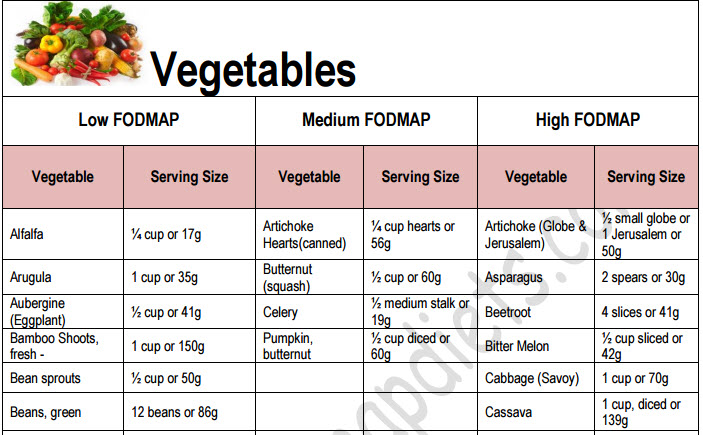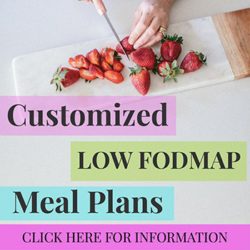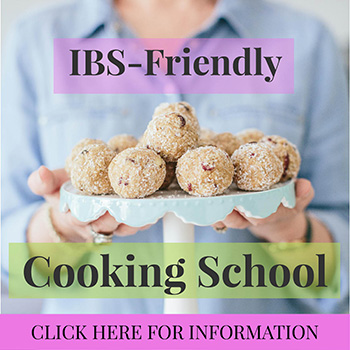The Best Diet for IBS Sufferers – The Low-FODMAP Diet Explained
For those of you who don’t know, Irritable Bowel Syndrome or IBS for short, is a functional gastrointestinal disorder, which is fairly common in most part of the world, in fact around 15% of the population in countries such as Australia, USA, Europe and most part of Asia is suffering from it, although only about 5% are aware of it. The condition is mainly characterised by chronic and relapsing symptoms, such as:
- Lower abdominal pain and discomfort
- Diarrhoea
- Constipation
- Alternation of diarrhoea and constipation
- Bloating
- Wind
- and more
IBS can be classified in three predominant types:
diarrhoea-predominant (IBS-D),
constipation-predominant (IBS-C), or
with alternating stool pattern (IBS-A) or IBS-M for mixed.
Since the symptoms of IBS are many, diagnosis should always be carried out by a qualified medical practitioner before treatment can begin, also to rule out other conditions.
The low FODMAP Diet
So, what is a low FODMAP diet? Well, to start off, the acronym stands for:
F ─ Fermentable
O ─ Oligosaccharides, which basically means short chain carbohydrates
D ─ Disaccharides (lactose)
M ─ Monosaccharides (fructose)
A ─ and
P ─ Polyols (sorbitol, mannitol, xylitol and maltitol)
FODMAPs are mainly found in everyday foods such as: wheat, barley, rye, onions, garlic, legumes, dairies like milk and ice cream, fruits such as apples, pears, watermelon, prunes etc., some vegetables, sugar-free gum, mints, honey and this is just to name a few.
For a complete list of food, keep on reading…..
FODMAPs have shown to have a cumulative impact on gastrointestinal symptoms, and are poorly absorbed in the small intestine, consequently they ferment producing symptoms of IBS.
Patients that are on the first phase of a low FODMAP diet (elimination phase) go without consuming any high FODMAP-rich foods.
IBS sufferers should be followed by an experienced dietitian when undertaking the different phases of the diet.
Low FODMAPs Diet Is Not For Everyone
In a recent study, over 75% of IBS patients showed an improvement while on the low FODMAP diet. Research also backs the fact that ingesting high FODMAPs food increase symptoms in most people with IBS, while dietary restriction of FODMAPs improves their symptoms.
As it is with all forms of treatment, everybody is different and while some people will notice an incredible improvement by reducing their FODMAPs intake, there will be those who don’t.
It’s always best to discuss any changes you wish to bring to your diet, with your health professional, especially if you are suffering with IBS. If you are considering a low-FODMAP diet, talk to your doctor or dietitian first before making any drastic changes to your everyday routine and diet. The internet is filled with articles about the diet and IBS, some sources are more credible than others, so you should always validate them with an expert.
The Low FODMAP Diet iPhone and Android App from Monash University
One of the best tool available to IBS sufferers, who want to follow a low FODMAP diet, is the phone app created by Monash University, which is available for iPhones and for Androids.
My dietitian suggested me to download this app, when I was first diagnosed with IBS and I don’t know what I would have done without it, especially the first few months of following the low FODMAP diet. It is handy because you can consult it when you are out at a restaurant and need to quickly check if the food is high or low FODMAPs before ordering or when you go food shopping and also when your friends invite you for dinner and ask you what you can or cannot eat, in order not to flare up your IBS.
For those who have not an iPhone or android smartphone, you can find here the Low FODMAP Diet Shopping List Guide, which I have compiled by following the guide of the Monash University low FODMAP app (October 2016). You are welcome to use it, but if you can download the app, that has a lot of useful information and it is regularly updated.
Summary:
The Low-FODMAP diet plan for IBS has a cumulative impact on gastrointestinal symptoms and can help patients suffering from abdominal pain, discomfort, bloating and altered bowel habits. Foods rich in high FODMAP include wheat, pears, apples, honey, mints etc. and avoiding them in a monitored routine with low-FODMAP foods and diet can bring significant improvements to your condition.
Disclaimer:
Please note that I’m not a doctor, a nutritionist, a registered dietitian and neither a fitness expert. In this blog I am sharing my experience with IBS, with food and life. This is purely my experience and it is not my intention to give you advice. When it comes to your health and fitness, consult your GP and do your research.






what proteins powders are fodmaps friendly? thank you
Is oat milk low in fodmap? I have bacteria overgrowth in my gut so I want to try the low foodmap diet for a while until I get rid of the overgrowth. thank you
Is water chestnut flour a high in food maps?
Hi Cathy, the flour made from water chestnut has not been specifically tested, but water chestnut has by Monash University and it’s low for a serving of 1/2 cup or 75 grams.
Hi, I am Asha from India. I m a Nutritionist who has done the dietitian’s course for Low FODMAP from Monash Uni. There are so many local food items that is not listed in the FODMAP site not the App. What is that we can do so that these foods can also be tested and it will be of very much help for the people who are going through IBS?
I am diagnosed with IBS-C. I get started trouble with gas as soon as I eat Chicken, Cream Cheese, Sugar based items like Cake , processed food like Potato Chips. I get gas with beer. So I avoid these items ( Aslo these are the main items available if you go to any Party !, So I my brain suggest avoid partys ). I was wondering why these items are in low food section in the shopping list.
If I don’t see the food on any list, does that mean I should avoid altogether? For example, pinto beans (canned) and corn, whole kernel (canned).
Hi Sheri, during the elimination phase, you may want to avoid food that you are not sure about. Although I have found pinto beans and corn kernels (canned) in various low FODMAP apps and they are high FODMAP, therefore need to be avoided during the elimination phase.
thanks for posting this, although it says sweet potatoes are high but every other list i have read, they are low? very confusing.
Hi Nat, thank you for your comment, if you have the Monash University app, sweet potatoes are low for 1/2 cup (70 g), medium for 3/4 cup (107) and high for 1 cup (140 g).
Thank for explaining was wondering why some times I could eat sweet potatoes and other times they had me sick. I was eating too much.
The other food confuses me is the banana ripe or unripe ?
Hi Diana, thank you for taking the time to comment on my article. In term of bananas, a banana is low FODMAP when it’s unripe, let’s say before it gets brown spots on the skin, when it’s still nice and firm.
Can you help me with the diet ? How much do you charge?
Hi Diana, I’m not qualified to give you health and nutrition advice, but I would recommend Suzanne Perazzini, who has an excellent low FODMAP coaching program. I am an affiliate of Suzanne’s programs, if you are interested to check it out this is the link.
Hi.
I have IBS and Acid reflux (GERD). Some foods that you can eat in FODMAP I cant eat for my Acid reflux? Any help and food list for both GERD and IBS? Dont know what to eat or make for dinner at all. Feel so depressed an helpless. Always in constant pain and discomfort…
Hi Roani, I’m so sorry, you feel like that. Have you been followed by a dietitian at all? Both IBS and GERD symptoms are very individual and what works for me, may not work for you. Saying that to reduce my acid reflux, I was told to avoid fatty, greasy and fried food, and also fizzy drinks, chocolate, citrus fruits, just to mention some. So I did reduce those a lot, when I started the low FODMAP diet I initially ate very basics food. A big difference for me, it was when I started to lose some weight, my acid reflux also improved incredibly. I did not drink alcohol, nor coffee or smoked, so those were not issues for me, but these can also give you reflux. Here are some of the food that may ease GERD symptoms, which are also low FODMAP (check the serving level on the Monash University low FODMAP app): oatmeal, rice, quinoa, potato, carrot, broccoli (small portion), fennel, lean meat and fish, low fat dressing, low fat dairy products, banana, melon, strawberries. Have small meals and don’t eat just before going to bed, can also help. Because now my acid reflux is much better I can eat a bigger variety of food (mainly low FODMAP). Please let me know how you are doing. Take good care for now. xo Larah
Good work, although there are some foods on this list, I know I cannot eat; as lettuce (any kind), strawberry and some other. My belly looks like as 9 months’ triplets pregnant and cramps are unbearable. Next day sure I will spend the morning at the loo. If it just a leaf or a bowl is the same. There is an explanation for that?
I also have some questions; what about fried food? I travel a lot, do the changing of microflora affect it? Water mineral contents? I try to avoid the ones with high mineral content. It is right?
I´ve been in many doctors, made 1,000,000 of exams and nothing… everything is normal. But if I put a piece of anything in my mouth, then puff!!! Literally.
Hi Beatriz and thank you for your comment. I can understand you perfectly. It is hard to be diagnosed of IBS. The doctor has to look at your medical history, your symptoms and how long you have been suffering from those symptoms. There are some breath tests that can identify malabsorption and food intolerance. My doctor gave me referrals for breath tests to check out lactose and fructose intolerance, plus blood test to see if I was celiac, internal organ scans etc. At the end by elimination of other diseases/illnesses he gave me the diagnosis of IBS. The food tested by Monash university, which you have found a copy on my blog, can be low FODMAP up to a certain quantity. For instance lettuce (all types) is tested low FODMAP for a cup, but that does not mean that everybody can tolerate even that quantity, while others may be able to tolerate a bit more. As you may know we can react to food differently, even if we all suffer from IBS. In my opinion it could be not only the fibres, but maybe other things that have gone onto the salad to preserve it or even bacteria, or a combination of other food you may have had in addition to the salad. Fried food is generally not healthy and the fat can trigger IBS symptoms, I avoid it as much as I can. Lots of travelling may be stressful, stress causes IBS symptoms too. Mineral water contains gas, so not that great for IBS either. Have you done both the elimination and re-introduction phases yet? If you haven’t, check out this article: https://www.lowfodmapdiets.com/ibs-diet/ – I do hope you will feel better very soon. xo Larah
I need help withy diet as well I have both IBS and gastritis . I take an PPI and Dr told me I can’t take Probiotics nor antibiotics.
I don’t know what to eat !
I feel lost depressed and alone .
I can’t find a Dietitian.
I seem 16 Drs and no one helps me.
Hi Diana, so sorry to hear about what’s happening with you. There are a lot more dietitians who are specialised in the low FODMAP diet, compared to a few years ago, but if you can’t find any near you, you may want to consider those who do telephone or Skype type consultations. Also you can find support in the private group I have created on Facebook and run with another two IBS sufferers who like me have found relief with adopting a low FODMAP diet, if you are interested search up the low FODMAP diet support group in Facebook. You will need to answer a couple of questions to be accepted. I hope to see you there. xo larah
How do I join a group and you guide me to dietitian?
You can join the private facebook group I run with another couple of IBS sufferers and low FODMAP experts, this is the link. You may find other group members who live near your area and may know a specialised low FODMAP dietitian. If not a lot of dietitians do telephone/skype consultations.
Thanks so much for providing a comprehensive low FODMAP food list, Larah. This will make life so much easier 🙂
Thank you SO MUCH for writing out and posting the Monash Food list from the app!!
I can’t tell you how much I appreciate this. I don’t have any sort of iphone, thus was not able to access this valuable resource.
I have severe FODMAP. Been deathly allergic/reactive to onions and garlic, among other things, for 40 years… but practitioners knew nothing of this disorder to help me.
Thank you again for posting this list.
Hi Tarenn, you are welcome. I understand where you come from, I had the same issues for years, before being diagnosed. All the best to you and keep on visiting I will be posting more articles and more recipes in the next few weeks.
“Bread, gluten free” is listed as low, but is main ingredients is usually rice, corn and potato flour. Is this right?
Hi earlb, Gluten free bread is not always low FODMAP, it depends on the ingredients. Usually IBS sufferers are not gluten intolerant, so it is not the gluten that gives them flares up, but it is the wheat, the barley, the rye in the bread and other ingredients. Bread which is based on rice flour, maize or corn-flour, potato-flour can be ok, if they don’t have added ingredients such as onion, inulin, apple/pear juices, honey and other high FODMAP ingredients. In Australia there is a brand called Alpine Bread which has a range of low FODMAP breads. Personally I don’t eat much bread, even low FODMAP one, I’m now having more quinoa and rice and keep the bread as a treat, maybe once a week.
Thanks for explaining what the FODMAP acronym meant, because that was a bit of a confusing term until you fully explained what it stood for. Also I have found the printable list of FODMAP food that you provide really useful.
Thank you Mike, I appreciate your comment. The low FODMAP diet is becoming more known and hopefully very soon more IBS sufferers are going to know about it. Let’s help to spread the word.
I had no idea such a diet existed. I have been trying to find something to help out my stomach. IBS runs in my family and it is something that has bugged me for years. I have went almost 10 days without going once. It was painful. My mother is the opposite so I have never been able to find what works for me.
I will read more on this diet and see if it is right for me. I want to get free from this once and for all! Thanks for all the information.
This is one of the most helpful and informative resources on your site. For those who are curious about the FODMAP diet and don’t know where to start, how about right here!
Still, I’d like to know more about your journey and how you’ve managed this diet in your daily life while still maintaining a high quality of life and enjoyment in the foods you eat.
I know not every path is the same, nor is there a map to success with IBS, but every experience helps!
Thank you for your feedback Shivettes, I will soon dedicate a few posts on how I gave up my beloved pasta, bread, pesto sauce (lots of garlic in it) and how I had to rearrange my whole family diet.